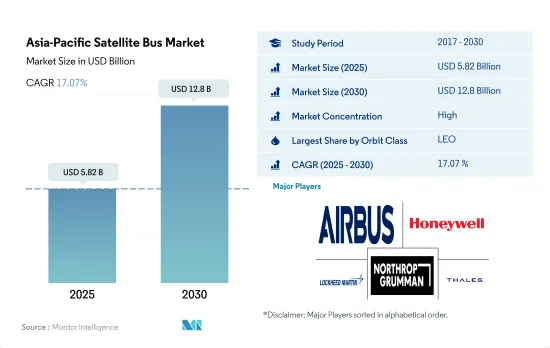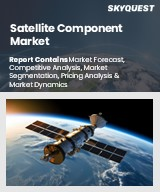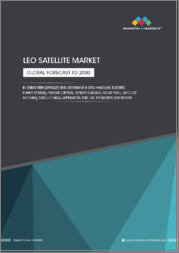
|
시장보고서
상품코드
1693931
아시아태평양의 위성 버스 시장(2025-2030년) : 시장 점유율 분석, 산업 동향, 성장 예측Asia-Pacific Satellite Bus - Market Share Analysis, Industry Trends & Statistics, Growth Forecasts (2025 - 2030) |
||||||
■ 보고서에 따라 최신 정보로 업데이트하여 보내드립니다. 배송일정은 문의해 주시기 바랍니다.
아시아태평양 위성 버스 시장 규모는 2025년에는 58억 2,000만 달러로 추정되며, 2030년에는 128억 달러에 이를 것으로 예측되고, 예측 기간(2025-2030년) 동안 CAGR 17.07%로 성장할 전망입니다.

LEO에 발사되는 위성이 시장 수요를 견인
- 아시아태평양에서는 광범위한 위성 궤도에 대응하는 위성 버스 수요가 크게 증가하고 있습니다. Spacety and Chang Guang Satellite Technology Co. Ltd.와 같은 기업이 LEO 미션용 위성 버스를 제공합니다. 중국은 이 지역에서 Gaofen 시리즈 위성 발사를 적극적으로 실시했습니다.
- GEO 위성은 텔레비전 및 인터넷과 같은 통신 및 방송 서비스에 특히 중요합니다. ISRO 및 Antrix Corporation Ltd와 같은 기업이 통신 미션용 첨단 위성 버스를 개발하고 있습니다.
- GPS와 갈릴레오 등의 MEO 위성은 세계 네비게이션과 측위 서비스에서 점점 중요해지고 있습니다. 중국은 또한 항법 시스템을 발사하여 MEO 위성에 투자하고 있습니다.
아시아태평양 위성 버스 시장 동향
이 지역에서는 더 나은 연료와 운영 효율을 사용하는 경향이 나타나고 있습니다ㅣ.
- 최근에는 민간/정부, 상업, 군사 부문에서 위성 수요가 증가하고 있습니다. 이와 함께 위성 버스의 제조 거점은 세계의 여러 나라로 확대될 것으로 예측됩니다.
- 2019년, 탈레스 알레니아 스페이스는 인도네시아의 컨소시엄 PSN을 위한 강력한 통신 위성의 설계와 조립을 인도네시아에서 수주했습니다. 해당 위성은 플랫폼 '스페이스 버스 네오'를 베이스로 합니다. 위성이 무거워지면 우주에 발사하기 위해 큰 로켓과 많은 연료가 필요하게 되므로 발사 비용이 상승하고 사용할 수 있는 로켓 유형도 한정됩니다.
- 질량별 주요 분류 유형은 1,000kg을 넘는 대형 위성입니다. 2017-2022년 동안 발사된 65기 이상의 위성이 아시아태평양의 조직에 의해 운용되었습니다.
각 우주 기관의 우주 개발비 증가는 위성 산업에 긍정적인 영향을 미칠 것으로 예측됩니다.
- 공동으로 서비스를 제공하는 소형 위성의 별자리와 네트워크의 개발은 새로운 동향입니다. 군용과 민간용의 이중 목적으로 증가하는 상업 위성 플랫폼의 확대가 시장을 밀어 올리고 있습니다.
- 아시아태평양에서 우주 관련 활동 증가를 고려하여 위성 제조업체는 급속히 상승하는 시장의 잠재력을 이용하기 위해 위성 제조 능력을 강화하고 있습니다. 중국은 국가 및 민간 우주 인프라와 지상 시설의 강화를 포함한 2021-2025년 우주 탐사 우선순위를 발표했습니다.
아시아태평양 위성 버스 산업 개요
아시아태평양의 위성 버스 시장은 상당히 통합되어 있으며 상위 5개 기업에서 71%를 차지하고 있습니다.
기타 혜택
- 엑셀 형식 시장 예측(ME) 시트
- 3개월간 애널리스트 서포트
목차
제1장 주요 요약과 주요 조사 결과
제2장 보고서 제안
제3장 소개
- 조사의 전제조건과 시장 정의
- 조사 범위
- 조사 방법
제4장 주요 산업 동향
- 위성의 소형화
- 위성 질량
- 우주 개발에의 지출
- 규제 프레임워크
- 호주
- 중국
- 인도
- 일본
- 뉴질랜드
- 싱가포르
- 한국
- 밸류체인과 유통채널 분석
제5장 시장 세분화
- 용도
- 통신
- 지구 관측
- 네비게이션
- 우주 관측
- 기타
- 위성 질량
- 10-100kg
- 100-500kg
- 500-1,000kg
- 10kg 이하
- 1,000kg 이상
- 궤도 클래스
- GEO
- LEO
- MEO
- 최종 사용자
- 상업
- 군사 및 정부
- 기타
제6장 경쟁 구도
- 주요 전략 동향
- 시장 점유율 분석
- 기업 상황
- 기업 프로파일
- Airbus SE
- Ball Corporation
- Honeywell International Inc.
- Indian Space Research Organisation(ISRO)
- Lockheed Martin Corporation
- Nano Avionics
- NEC
- Northrop Grumman Corporation
- Thales
제7장 CEO에 대한 주요 전략적 질문
제8장 부록
- 세계 개요
- 개요
- Porter's Five Forces 분석 프레임워크
- 세계의 밸류체인 분석
- 시장 역학(DROs)
- 정보원과 참고문헌
- 도표 일람
- 주요 인사이트
- 데이터 팩
- 용어집
The Asia-Pacific Satellite Bus Market size is estimated at 5.82 billion USD in 2025, and is expected to reach 12.8 billion USD by 2030, growing at a CAGR of 17.07% during the forecast period (2025-2030).

Satellites that are being launched into LEO is driving the market demand
- The Asia-Pacific region has seen a significant increase in the demand for satellite buses to accommodate a wide range of satellite orbits. This demand has been driven by the growing need for satellite-based communication, navigation, and remote sensing services. Earth observation satellites have become increasingly popular for a wide range of applications. The demand for LEO satellites has been particularly strong in China, where companies such as Spacety and Chang Guang Satellite Technology Co. Ltd. offer satellite buses for LEO missions. China has been active in this region with the launch of the Gaofen series satellites. Between 2017 and 2022, approximately 379 satellites were launched into LEO.
- GEO satellites are particularly important for communication and broadcasting services, such as television and the Internet. The demand for GEO satellites has been particularly strong in India, where companies such as ISRO and Antrix Corporation Ltd have been developing advanced satellite buses for communication missions. China has also been investing heavily in GEO satellites, with the launch of the Zhongxing series of communication satellites. Between 2017 and 2022, approximately 66 satellites were launched into GEO.
- MEO satellites, such as GPS and Galileo, have become increasingly important for global navigation and positioning services. Japan has been a leader in Asia-Pacific, with the launch of the Michibiki series of MEO navigation satellites. China has also been investing in MEO satellites with the launch of the Beidou navigation system. Between 2017 and 2022, approximately 24 satellites were launched into MEO. The overall market is expected to grow by 20.72% during 2023-2029.
Asia-Pacific Satellite Bus Market Trends
The trend of using better fuel and operational efficiency has been witnessed in the region
- Increased demand for satellites from the civil/government, commercial, and military segments has been witnessed in recent years. Countries like China, India, and Japan have adequate capabilities in the area of satellite bus manufacturing. However, along with the growing shift toward manufacturing smaller satellites, the manufacturing base of satellite buses is expected to expand to various countries across the world. The mass of a satellite has a significant impact on the launch of the satellite. This is because the heavier the satellite, the more fuel and energy are required to launch it into space.
- In 2019, Thales Alenia Space was selected by Indonesia to design and assemble a powerful telecommunication satellite for the Indonesian consortium PSN. The launch was scheduled for the end of 2022. The satellite will be based on the full electric platform Spacebus Neo. A heavier satellite requires a larger rocket and more fuel to launch it into space, thus increasing the cost of the launch and limiting the types of launch vehicles that can be used.
- The primary classification types according to mass are large satellites that are more than 1,000 kg. During 2017-2022, around 75+ large satellites launched were owned by Asia-Pacific organizations. A medium-sized satellite has a mass between 500 and 1000 kg. More than 65+ satellites launched were operated by Asia-Pacific organizations. Similarly, satellites weighing less than 500 kg are considered small satellites, and around 200+ small satellites were launched in the region.
The increasing space expenditures of different space agencies are expected to positively impact the satellite industry
- The development of constellations or networks of small satellites working together to provide a collective service is an emerging trend. These constellations often consist of dozens or even hundreds of small satellites that communicate with each other to achieve mission goals. Distributed satellite networks provide improved coverage, redundancy, and flexibility compared to traditional large satellites. The growing utilization of commercial satellite platforms for dual (military and civil) purposes has boosted the market. Satellite communications are envisioned to be an essential part of the 5G infrastructure. The satellite transport conduit is being integrated into the overall communication map to provide seamless connectivity. This will result in new opportunities for extending satellite services in urban and rural areas.
- Considering the increase in space-related activities in Asia-Pacific, satellite manufacturers are enhancing their satellite production capabilities to tap into the rapidly emerging market potentials. The prominent countries in Asia-Pacific that pose a robust space infrastructure are China, India, Japan, and South Korea. China National Space Administration (CNSA) announced space exploration priorities for the 2021-2025 period, including enhancing national civil space infrastructure and ground facilities. As a part of this plan, the Chinese government established China Satellite Network Group Co. Ltd for the development of a 13,000-satellite constellation for satellite internet.
Asia-Pacific Satellite Bus Industry Overview
The Asia-Pacific Satellite Bus Market is fairly consolidated, with the top five companies occupying 71%. The major players in this market are Airbus SE, Honeywell International Inc., Lockheed Martin Corporation, Northrop Grumman Corporation and Thales (sorted alphabetically).
Additional Benefits:
- The market estimate (ME) sheet in Excel format
- 3 months of analyst support
TABLE OF CONTENTS
1 EXECUTIVE SUMMARY & KEY FINDINGS
2 REPORT OFFERS
3 INTRODUCTION
- 3.1 Study Assumptions & Market Definition
- 3.2 Scope of the Study
- 3.3 Research Methodology
4 KEY INDUSTRY TRENDS
- 4.1 Satellite Miniaturization
- 4.2 Satellite Mass
- 4.3 Spending On Space Programs
- 4.4 Regulatory Framework
- 4.4.1 Australia
- 4.4.2 China
- 4.4.3 India
- 4.4.4 Japan
- 4.4.5 New Zealand
- 4.4.6 Singapore
- 4.4.7 South Korea
- 4.5 Value Chain & Distribution Channel Analysis
5 MARKET SEGMENTATION (includes market size in Value in USD, Forecasts up to 2030 and analysis of growth prospects)
- 5.1 Application
- 5.1.1 Communication
- 5.1.2 Earth Observation
- 5.1.3 Navigation
- 5.1.4 Space Observation
- 5.1.5 Others
- 5.2 Satellite Mass
- 5.2.1 10-100kg
- 5.2.2 100-500kg
- 5.2.3 500-1000kg
- 5.2.4 Below 10 Kg
- 5.2.5 above 1000kg
- 5.3 Orbit Class
- 5.3.1 GEO
- 5.3.2 LEO
- 5.3.3 MEO
- 5.4 End User
- 5.4.1 Commercial
- 5.4.2 Military & Government
- 5.4.3 Other
6 COMPETITIVE LANDSCAPE
- 6.1 Key Strategic Moves
- 6.2 Market Share Analysis
- 6.3 Company Landscape
- 6.4 Company Profiles (includes Global Level Overview, Market Level Overview, Core Business Segments, Financials, Headcount, Key Information, Market Rank, Market Share, Products and Services, and Analysis of Recent Developments).
- 6.4.1 Airbus SE
- 6.4.2 Ball Corporation
- 6.4.3 Honeywell International Inc.
- 6.4.4 Indian Space Research Organisation (ISRO)
- 6.4.5 Lockheed Martin Corporation
- 6.4.6 Nano Avionics
- 6.4.7 NEC
- 6.4.8 Northrop Grumman Corporation
- 6.4.9 Thales
7 KEY STRATEGIC QUESTIONS FOR SATELLITE CEOS
8 APPENDIX
- 8.1 Global Overview
- 8.1.1 Overview
- 8.1.2 Porter's Five Forces Framework
- 8.1.3 Global Value Chain Analysis
- 8.1.4 Market Dynamics (DROs)
- 8.2 Sources & References
- 8.3 List of Tables & Figures
- 8.4 Primary Insights
- 8.5 Data Pack
- 8.6 Glossary of Terms
샘플 요청 목록

















